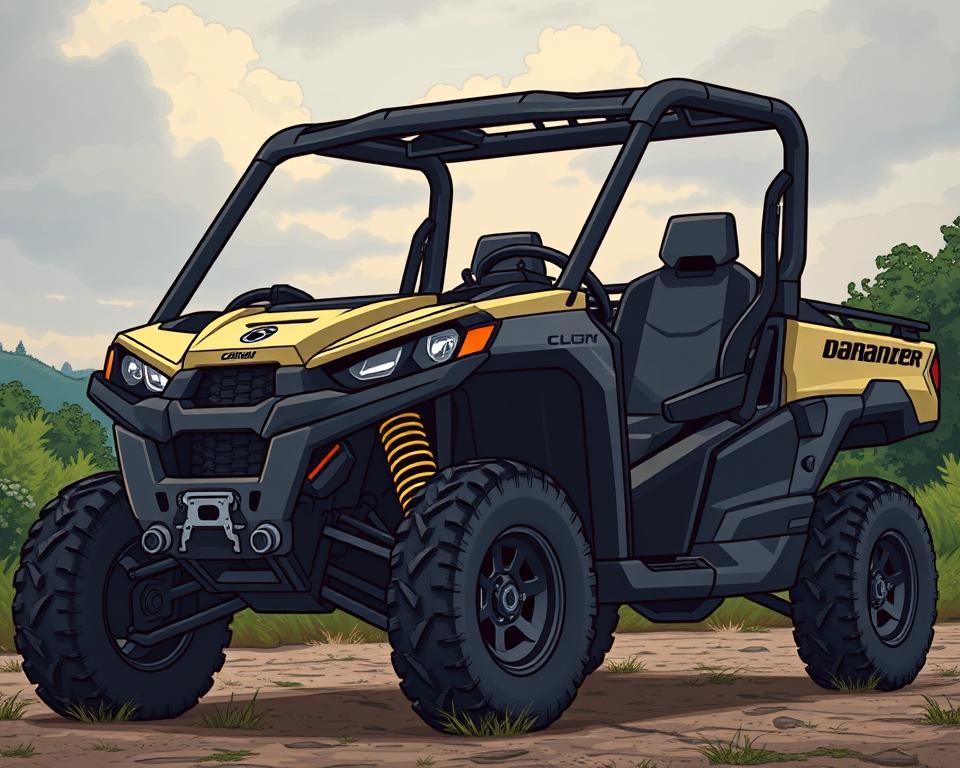Your Go-To ATV Off-Road Checklist for Confident Rides
“It’s not the mountain we conquer but ourselves.” — Sir Edmund Hillary.
This streamlined guide sets a practical tone for smart packing and pre-trail checks. You’ll learn how a well-stocked kit keeps you prepared for typical trail issues and unplanned holdups with Honda talon sound bar.
We present a simple checklist of personal gear, vehicle setup, nav tools, tire care, recovery tools, power/lighting plans, plus pack-out items. Expect simple tips on matching gear to terrain and time-window planning to save time and reduce risk.
Brought to you by American Off-Roads, your go-to U.S. parts supplier and rider resource, this guide shows which parts are worth packing and which items you can skip. Dive in to ride with more confidence and efficiency.

Trail-Ready Today: What This ATV and UTV Safety Checklist Covers Today
Before you roll, know which inspections and kits maximize reliability and safety.
This fast reference covers the key areas to check so you can make sure nothing gets left behind or buried in storage you can’t reach on the trail.
We call out key systems that determine comfort and reliability. That includes protective gear, medical basics, lighting, and mechanical checks.
- Navigation and communication: use offline GPS with printed maps for remote areas.
- Tires & traction: carry plugs, a spare tire, a compressor, and deflators for sand, rock, or hardpack.
- Recovery tools: rated straps, soft shackles, gloves to self-rescue without long waits.
- Power & lighting: plan switch layout and draw to protect the charging system.
| Category | Key Items | Source |
|---|---|---|
| Personal Gear | Helmet + gloves + goggles | American Off-Roads or certified shops |
| Repair | Tire plugs, compact compressor, deflator | Specialty parts shops, online |
| Recovery | Rated straps, shackles, tree-saver | Manufacturer stores, American Off-Roads |
This guide links gear to real situations so your vehicle performs well across different terrains and trip lengths. Follow this way for quick, repeatable pre-ride prep that better organizes every ride experience.
Essential ATV/UTV Off-Road Checklist
Pack with purpose: a pre-staged grab-and-go bag shrinks prep effort and keeps critical items within reach.
Personal protective gear
Lead with certified head protection that meets DOT, Snell, or ECE standards. Add clear/tinted goggles for variable light and breathable gloves with reinforced palms and knuckles.
Add proper body armor to reduce fatigue and impact on longer rides.
Machine prep and systems
Check controls, steering feel, brakes, and throttle response before leaving. Check fluids and inspect for leaks.
Fit a compact battery jump-starter with reverse-polarity protection; many also charge phones and GPS. Verify lights are aimed and account for added lighting current.
Trail essentials
Layer your nav with an offline-capable gps and a marked paper map for redundancy.
Carry a compact repair kit: wrenches, screwdrivers, duct tape, tire plugs, spare tire, compressor, and deflators. Bring straps, shackles, and a winch if your rig supports it.
Keep food and hydration easy to reach so you can eat/drink without digging.
| Kit | Key Items | Why it matters | Storage Spot |
|---|---|---|---|
| Rider | Helmet, goggles, gloves, body armor | Cuts injury risk; manages heat | Labeled bag in cab or rear box |
| Power & Lights | Jump-starter + spare bulbs | Avoids dead starts; keeps visibility | Locked bin or padded case |
| Repair & Recovery | Tool roll, tire plugs, straps, shackles | Quick fixes; self-recovery | Weatherproof bag or box |
| Nav/Comms | Offline GPS + map + radio | Keeps group coordinated off-grid | Dash pouch or front storage |
American Off-Roads makes it easy to build and label storage by category so you can grab the right bag and save time on prep day. A clean layout boosts on-trail safety and gets you riding sooner.
Protective Riding Gear That Shields You from Debris, Weather, and Impact
Quality protective gear keeps you riding longer and reduces injury risk when trails turn nasty.
Choose a helmet that meets DOT, Snell, or ECE standards and fits properly. Choose one with strong ventilation, a moisture-wicking liner, and a wide eyeport so vision remains clear across changing terrain.
Select gloves that blend reinforced palms and knuckle protection with breathable panels. That keeps your hands safe from debris and vibration while preventing overheating on long rides.
Layer a membrane suit for rain and wind protection, and use UV base layers for hot days. A snug face mask blocks dust/dirt while vents ease breathing and reduce heat buildup.
Choose boots for the route: rubber for easy clean, hikers for grip/ankle support, and wading systems for deep mud. Pick mud-shedding soles and give enough stiffness for peg support without sacrificing control.
| Item | Key features | Use Case | Care Tip |
|---|---|---|---|
| Lid | DOT/Snell/ECE, ventilation, wide eyeport | All-day trail riding | Replace after impact; clean liner |
| Riding gloves | Reinforced, protective, breathable | Protects hands from debris and vibration | Inspect seams; wash per label |
| Boots | Grip soles, ankle support, mud-shedding tread | Wet crossings, rocky or mixed terrain | Dry thoroughly; treat leather as needed |
Inspect armor panels/seams regularly so impact protection holds up. American Off-Roads can set you up with coordinated gear that balance airflow, weather protection, and impact resistance for your style of riding.
Navigation and Communication: Map Your Trail and Stay Connected
Redundant navigation help you stay on permitted routes and return on time.
Pick a rugged offline GPS with long battery life to navigate routes, record waypoints, and mark your parking spot for an easy way back. A solid unit will resist dust and vibration so it survives rough terrain.
Carry a waterproof tear-resistant map plus a compass as backups. Mark your intended trail and alternate exits from a Forest Service or park map so you can navigate if electronics quit.
Team comms and prep
Equip each team with weatherproof two-way radios and agree on channels and call signs before you roll. Do a comms check so everyone knows the call-in protocol if line-of-sight is lost in wooded areas.
- Set waypoints for fuel, camps, and rendezvous and share with the team.
- Schedule buffers for slow segments, photos, obstacles to protect timing.
- Keep a printed contact list with emergency numbers and park offices for quick assistance.
| Item | Why It Matters | Tip |
|---|---|---|
| Offline GPS | Routes + coordinates | Secure mount; AOR power leads |
| Map + compass | Failsafe when batteries die | Pre-mark route/alternates |
| Radios | Group coordination in low-signal areas | Weatherproof + spare cells |
Align map and gps routes with permitted trails and seasonal closures to avoid detours/fines. American Off-Roads can recommend mounts/cases that secure devices without cluttering the cockpit.
Tires, Air, and Traction: Keep Your Ride Gripping in Any Terrain
Good tire planning keeps you moving when dirt, sand, or snow try to stop you.
Carry a spare tire that matches your size/load. Pack plugs, tools, spare valve cores/caps so you can do fast on-trail repair.
Carry a compact compressor + reliable gauge to set proper air levels for each surface. Sand often runs best around 5–6 PSI, while rocks/hardpack need higher PSI.
- Stow traction boards or mats where they’re easy to reach to free stuck wheels in mud or snow.
- Keep tools and spare parts in labeled storage cubes so gear stays quiet and organized.
- Inspect sidewalls before each ride and replace if cuts/bulges show.
| Component | Why It Matters | Quick tip |
|---|---|---|
| Spare tire & plugs | Fix punctures and replace on severe damage | Match load rating; store upright in a secured mount |
| Compressor & gauge | Dial in PSI for sand, rock, or hardpack | Choose compact units with good flow rate |
| Traction boards & deflators | Quick recovery + fast deflate | Rear access; labeled deflators |
Record PSI and conditions during each ride to build a useful reference. Teach safe jacking points for your vehicle so repairs stay safe and avoid damage.
American Off-Roads can bundle tire repair gear, compact compressors, and deflators so everything lives in one labeled storage cube in your vehicle.
Self-Recovery Essentials: Winches & More
Good recoveries start with gear chosen for your vehicle and practiced by the crew.
Pick a winch rated at least 1.5x your vehicle weight and verify mount integrity and wiring. Match capacity to load so pulls stay safe and predictable. American Off-Roads can size your winch and recommend accessories that fit your rig the first time.
Choosing anchors and winch setup
Use tree savers when anchoring to living wood and keep pull angles low. Inspect anchor options in loose or soft terrain before you hook up. Walk the area to find firm ground and clear the exit path.
Recovery straps and shackles
Carry rated recovery straps, soft shackles, and D-rings sized to your rig. Soft shackles protect anchors and speed hookup. Keep metal hardware in a rigid bag so they don’t become in-cab hazards.
Useful safety add-ons
Add a line damper and a heavy blanket to reduce recoil risk if a cable fails. Wear durable gloves to protect hands from frayed strands and heat. A winch can also load a disabled machine or clear fallen limbs blocking the way.
| Gear | Why it matters | Quick Tip |
|---|---|---|
| Rated winch | Extraction and loading aid | Pre-test; verify mounts/wiring |
| Straps & shackles | Fast, flexible links | Use rated gear only |
| Tree saver + damper | Protects anchors; reduces recoil | Always wrap trees; place damper over line |
Power, Lighting & Emergency Prep
A small power/EM kit keep short failures from becoming long problems.
Bring a modern jump pack with spark-proof clamps and reverse-polarity protection. Many units double as chargers so you maintain communications.
Plan lighting in zones: front spot/flood for distance, ditch lights for peripheral hazards, and rear work for repairs. Sum total current and fuse circuits to protect your vehicle system and alternator.
- Keep a jump pack in easy storage so you reach it fast when time matters.
- Mount switches for gloved access and label each for quick night use.
- Use loom/grommets at pass-throughs to avoid chafing/damage.
- Pre-test jump pack and lights—simulate a dead battery and practice safe hookups.
Assemble a compact emergency kit with first-aid items, a compact extinguisher, multi-tool, whistle, and thermal blankets. Include chem lights or a strobe for after-dark visibility.
| Item | Why It Matters | Storage tip |
|---|---|---|
| Battery jump-starter | Restores charge; powers devices | Top-access pouch or dash bin |
| LED pods & switches | Focused light, low draw | Labeled switch panel |
| EM kit | Stopgap for incidents | Near-door, easy-reach bag |
American Off-Roads can help size wiring, fuses, and mounts so added lights and a jump pack integrate cleanly with your storage plan and existing systems for safe, reliable trail use.
Pack Smart: Fuel/Water/Storage & Trail Tips
Good packing balances weight, access, and protection so sudden weather or delays don’t ruin a ride.
Carry extra fuel and water in purpose-built containers and mount them low to keep weight centralized while riding rough sections. Secure fasteners and vents to avoid spills and fumes near the cab.
Pack dense snacks + a bladder so you sip steadily and maintain energy levels. Layer for heat/wind/cool nights; pack a lightweight insulating layer in a waterproof bag.
Protect gear and bodywork
Use hard cases or soft panniers designed to avoid panel scuffs. Add dividers/clear pouches so tools, small parts, and first aid items remain organized and visible.
- Mount frequently used items up front for quick access.
- Carry a notepad to track fuel mileage and water use for better resupply planning.
- Carry a trash bag plus a small comfort kit—wipes/sunscreen/repellent—to keep camp tidy and riders comfortable.
| Carry | Why it matters | Storage Tip |
|---|---|---|
| Fuel & water containers | Extend range; prevent dehydration | Low, secured mounts with vent protection |
| Soft luggage | Gear protection minus scuffs | Use padded straps and body-friendly contact points |
| Hydration bladder & food | Steady fluids; fast calories | Route hose for easy sipping while riding |
American Off-Roads can outfit vehicles with lockable, dustproof storage, proper fuel/water containers, and panel-friendly soft bags. That protects parts and keeps gear ready for every adventure.
To Conclude
Finish prep by confirming critical systems, staged gear, and simple backups so your ride goes smoother. This quick guide helps you turn planning into a reliable routine for safer and more enjoyable rides.
Make protection a priority that fits and breathes. Keep battery backup, lighting plans, layered nav plus paper map, recovery gear, and tire repair tools ready in reach.
Refresh consumables; schedule worn-part replacements. Run quick controls checks and a fast walk-around to catch small issues before they grow into delays or injury.
Organize storage, protect bodywork and plastic from mud and dirt, and tweak air and tool layouts until the whole setup flows. For parts, integration, and hands-on help, American Off-Roads can equip your ATV/UTV for the next adventure.


